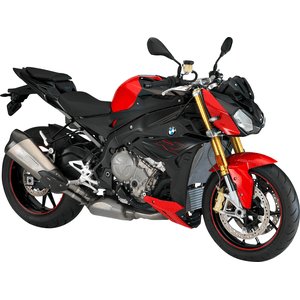BMW S 1000 R (2017–2020): The Apex Predator of the Super Naked Segment
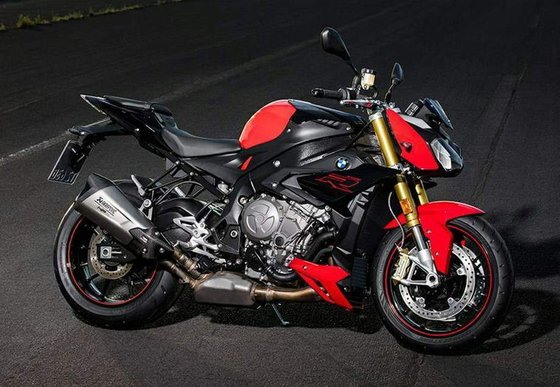
Introduction
The BMW S 1000 R isn’t just a motorcycle—it’s a declaration of intent. Stripped of the S 1000 RR’s fairings but retaining its ferocious heart, this super naked bike bridges the gap between track-ready aggression and street-smart versatility. Built on BMW’s "tail up, nose down" philosophy, the 2017–2020 generation refines an already explosive formula with sharper electronics, a lighter chassis, and a soundtrack that could wake the dead. Having spent a day hustling this Bavarian beast through twisties and city streets, here’s why it remains a benchmark in the hyper-naked category.
Design & Ergonomics: Brutalist Art Meets Functional Aggression
Stripped-Down Aesthetics
The S 1000 R’s design is a masterclass in purposeful minimalism. The asymmetrical headlight—a signature BMW Motorrad trait—dominates the front profile, flanked by a gaping air intake that screams performance. The side panels are ruthlessly trimmed down, exposing the engine’s mechanical poetry. BMW’s color schemes—Racing Red/Black Storm Metallic, Catalano Grey, and the Motorsport livery—add either understated menace or racetrack flair.
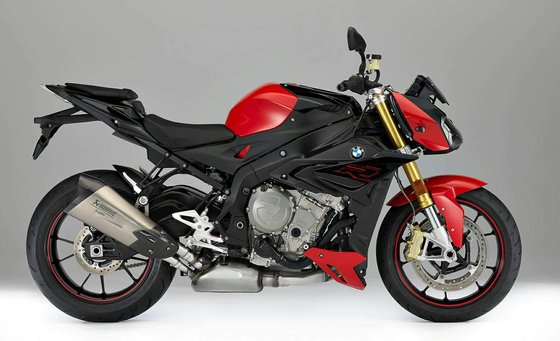
Rider-Focused Ergonomics
At 814 mm (32 inches), the seat height is accessible for most riders, though taller pilots might crave more legroom. The handlebars are vibration-free, a small miracle given the inline-four’s rev-happy nature. The riding position splits the difference between the RR’s tuck and a standard naked bike: slightly leaned forward, with pegs set mid-rear for agility. After an hour in the saddle, my wrists felt fresh—a rarity in this segment.
Engine & Performance: Controlled Fury
The Heart of the Beast
The 999 cc inline-four is a masterpiece. With 165 hp (121 kW) at 11,000 rpm and 114 Nm (84 lb-ft) of torque peaking at 9,250 rpm, it’s a neutron star of power density. Throttle response is crisp, whether you’re trickling through traffic or chasing the 14,000 rpm redline. The HP titanium silencer (standard post-2017) amplifies the engine’s snarl without crossing into obnoxious territory.
Gearbox & Clutch
The 6-speed transmission is butter-smooth, especially with the optional HP Shift Assistant Pro. Clutchless up/downshifts are seamless, and the anti-hopping clutch prevents rear-wheel chatter under hard braking. For track junkies, the quickshifter supports a "GP shift" pattern (1-up, 5-down) via a simple linkage swap.
Technology & Electronics: Your Digital Co-Pilot
Riding Modes & Safety Nets
Standard features include Rain and Road modes, which tweak throttle response, torque delivery, and ABS/ASC intervention. Opt for the Riding Modes Pro package, and you’ll unlock Dynamic and User modes, plus ABS Pro (cornering ABS) and DTC (Dynamic Traction Control). The latter uses a banking sensor to adjust slip limits mid-corner—a game-changer for spirited rides.
Suspension & Chassis
The aluminum bridge frame sheds 2 kg (4.4 lbs) over previous iterations, sharpening turn-in. Suspension duties are handled by a 46 mm USD fork (adjustable for compression/rebound) and a rear shock with preload/rebound adjustability. The optional Dynamic Damping Control (DDC) adds electronic adjustment, adapting to road conditions in real time.
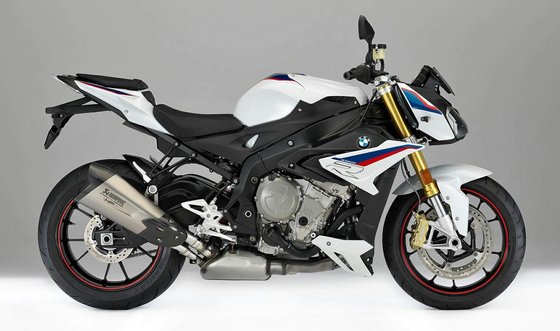
Competition: How the S 1000 R Stacks Up
Ducati Monster 1200 S
- Power: 150 hp | Weight: 209 kg (461 lbs)
- The Monster’s V-twin delivers gruntier low-end torque, but its tech suite feels dated compared to BMW’s DTC and ABS Pro. The S 1000 R’s 4 kg (8.8 lbs) weight advantage shines in flickable transitions.
Yamaha MT-10
- Power: 160 hp | Weight: 210 kg (463 lbs)
- Yamaha’s CP4 engine is a torque monster, but its suspension and electronics lack the BMW’s precision. The MT-10’s bargain pricing undercuts the S 1000 R, but you lose the HP titanium exhaust and forged wheels.
KTM 1290 Super Duke R
- Power: 177 hp | Weight: 198 kg (437 lbs)
- The KTM’s LC8 V-twin is unhinged, offering apocalyptic acceleration. Yet its minimalist tech package and stiff seat make the BMW feel like a Swiss Army knife by comparison.
Verdict: The S 1000 R strikes a rare balance between track-day weapon and daily rider. It out-handles the Monster, out-techs the MT-10, and out-refines the Super Duke.
Maintenance: Keeping the Beast Alive
Key Service Intervals
- Oil Changes: Every 10,000 km (6,200 miles) with BMW’s 5W-40 synthetic.
- Valve Adjustments: Every 20,000 km (12,400 miles). Cold clearance: intake 0.11–0.20 mm, exhaust 0.26–0.35 mm.
- Chain Care: BMW recommends lubrication every 500 km (310 miles). Swap the stock 17/45 sprockets for a 16T front for quicker acceleration.
Upgrade Recommendations from MOTOPARTS.store
- HP Forged Wheels: Save 2.4 kg (5.3 lbs) for sharper handling.
- Comfort Seat: Add 20 mm of foam for marathon rides.
- HP Brake/Clutch Levers: Foldable design prevents snap-offs in drops.
- Sport Windshield: Reduces highway fatigue without ruining the bike’s lines.

Conclusion: The Super Naked for the Discerning Rider
The 2017–2020 BMW S 1000 R isn’t just a motorcycle—it’s a triumph of engineering masquerading as a roadster. It’s as comfortable carving canyons as it is commuting, all while wrapped in a tech cocoon that anticipates your mistakes. Whether you’re upgrading suspension, bolting on carbon fiber, or just keeping it stock, MOTOPARTS.store has the gear to keep this Bavarian icon at its peak.

Ride hard, ride smart.

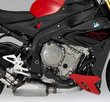





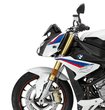


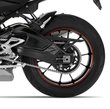


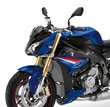

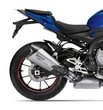

Specifications sheet
| Engine | |
|---|---|
| Stroke: | Four-stroke |
| Max power: | 121 kW | 162.0 hp |
| Max torque: | 112 Nm |
| Fuel system: | Electronic fuel injection, BMS-KP digital electronics |
| Max power @: | 11000 rpm |
| Displacement: | 999 ccm |
| Max torque @: | 9250 rpm |
| Bore x Stroke: | 80 x 49.7 mm (3.1 x 2.0 in) |
| Configuration: | Inline |
| Cooling system: | Liquid |
| Emission control: | EU-4 with two three-way catalytic converters |
| Compression ratio: | 12.0:1 |
| Number of cylinders: | 4 |
| Valves per cylinder: | 4 |
| Wheels | |
|---|---|
| Rear wheel: | 6.00 x 17 |
| Front wheel: | 3.50 x 17 |
| Optional wheels: | HP forged wheels (2.4 kg lighter) |
| Dimensions | |
|---|---|
| Wheelbase: | 1440 mm (56.7 in) |
| Dry weight: | 178 |
| Wet weight: | 205 |
| Seat height: | 813-814 mm (32.0-32.0 in) |
| Overall width: | 845 mm (33.3 in) |
| Overall height: | 1228 mm (48.3 in) |
| Overall length: | 2057 mm (81.0 in) |
| Ground clearance: | 165 mm (6.5 in) |
| Fuel tank capacity: | 17.5 L (4.6 US gal) |
| Drivetrain | |
|---|---|
| Final drive: | chain |
| Gear ratios: | {'1st': 2.647, '2nd': 2.091, '3rd': 1.727, '4th': 1.5, '5th': 1.36, '6th': 1.261} |
| Transmission: | 6-speed |
| Primary ratio: | 1.652 |
| Rear sprocket: | 45 |
| Front sprocket: | 17 |
| Electronics | |
|---|---|
| ABS: | BMW Motorrad Race ABS (partially integral, disengageable) |
| Riding modes: | Rain, Road (Dynamic/User/Dynamic Pro optional) |
| Shift assistant: | HP Shift Assist Pro (optional) |
| Traction control: | ASC standard (DTC optional) |
| Instrument cluster: | LCD with analog tachometer, gear indicator and lap timer |
| Maintainance | |
|---|---|
| Rear tire: | 190/55 z-17 |
| Engine oil: | SAE 5W-40 |
| Front tire: | 120/70 z-17 |
| Brake fluid: | DOT 4 |
| Spark plugs: | NGK LMAR9D-J |
| Spark plug gap: | 0.7-0.9 mm |
| Coolant capacity: | 2.9 |
| Engine oil capacity: | 3.5 |
| Chain maintenance interval: | Every 1000 km (620 mi) |
| Engine oil change interval: | Every 5000 km or 2 years |
| Valve clearance (intake, cold): | 0.11-0.20 mm |
| Valve clearance check interval: | 24,000 km (15,000 mi) |
| Valve clearance (exhaust, cold): | 0.26-0.35 mm |
| Recommended tire pressure (rear): | 2.9 bar (42 psi) |
| Recommended tire pressure (front): | 2.5 bar (36 psi) |
| Chassis and Suspension | |
|---|---|
| Frame: | Aluminum bridge frame with self-supporting engine |
| Trail: | 98.5 mm (3.88 in) |
| Rear brakes: | 220 mm disc, 1-piston caliper (Optional Race ABS) |
| Front brakes: | 2 x 320 mm discs, 4-piston radial calipers (Optional Race ABS) |
| Rear suspension: | Aluminum double-strut swingarm with central spring strut |
| Front suspension: | 46 mm USD fork, adjustable compression/rebound (electronically adjustable DDC on some models) |
| Rear wheel travel: | 120 mm (4.7 in) |
| Front wheel travel: | 120 mm (4.7 in) |
| Steering head angle: | 65.4° |



